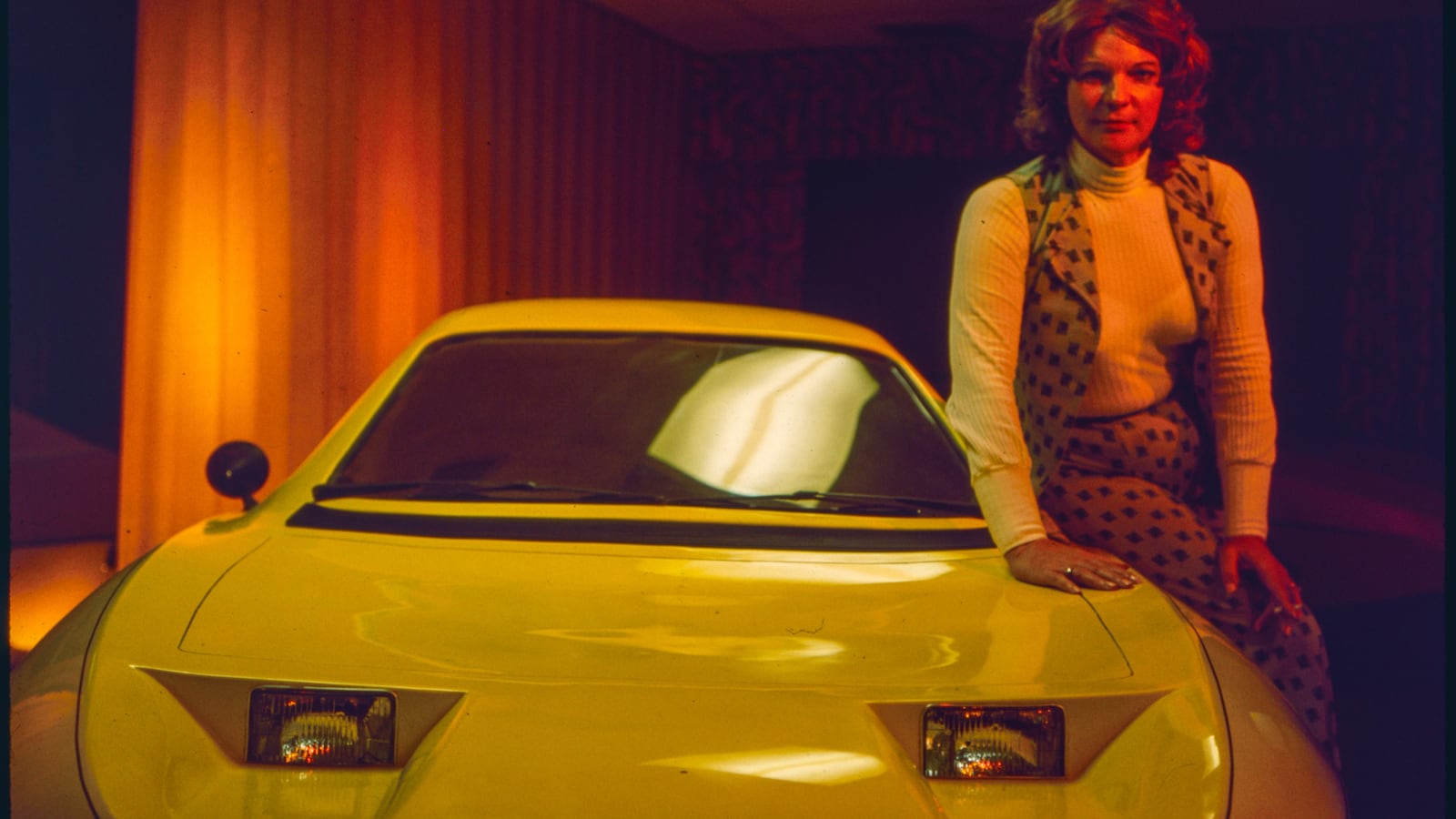If you’re going to be a criminal, it’s wise to maintain a low profile. Alas, playing it safe isn’t in most lawbreakers’ DNA, and that was certainly the case with Geraldine Elizabeth “Liz” Carmichael, who in 1974 took the world by storm by taking on Detroit’s “Big Three” auto manufacturers with the Twentieth Century Motor Car Corporation and its flagship product: the Dale, a three-wheeled car that promised to deliver 70 miles per gallon, thus making it the ideal vehicle for an oil crisis-wracked America. By the time Liz launched this dodgy creation, she had already begun transitioning into a woman, which added even more fuel to the media-frenzy fire that would soon engulf her.
Directed by Nick Cammilleri and Zackary Drucker, and executive produced by Jay and Mark Duplass (Wild Wild Country), HBO’s four-part docuseries The Lady and the Dale (debuting Jan. 31) begins with the rollicking early years of Liz’s life, when prior to transitioning she married and abandoned two wives—and the multiple kids she had with them—before shacking up with third spouse Vivian. They had five children together, and as Vivian’s brother Charles remembers, Liz (then known as Jerry) was always a gregarious sort of grifter, adept at creating fake identities and swindling suckers (especially businesses) out of their hard-earned cash. Given Liz’s fondness for con-artist schemes, it wasn’t long before the Michael clan was fleeing from federal agents thanks to an elaborate counterfeiting ruse. Present-day recollections from daughter Candi paint a picture of an itinerant life on the run, such that she and her siblings’ birth certificates boast phony names—a situation that still causes them headaches.
The Lady and the Dale spends almost its entire first installment on Liz’s wild backstory, which is enlivened by pop-up book-esque animated reenactment sequences created with old photos of the players in question. It’s a novel stylistic twist that further conveys the craziness of the Michaels’ early years, in which family gatherings were organized through coded newspaper messages, and everyone had to be ready, at a moment’s notice, to take flight in the middle of the night to a new town and home. In short, Liz was an inveterate charlatan. She was also a trans woman, and while evading authorities, she slowly began the process of transitioning—a development that was readily accepted by her children and, after some minor initial hesitation, her wife Vivian.
Following a surgical procedure in Tijuana, Liz began living publicly as a woman, and in 1973, while working at a marketing company, she discovered an invention that was as brash and unconventional as she was: the Dale, a three-wheeled car (created by Dale Clifft) that she immediately decided would be her revolutionary ticket to world domination. After overhauling Clifft’s original designs to make the Dale more attractive (replete with a canary yellow paint job), Liz got a prototype into the Los Angeles Auto Show. Then, she went on a press blitz to announce her intentions to take on America’s auto bigwigs—including by getting the Dale featured on The Price is Right. Before long, Liz was a front-page sensation, with the uniqueness of her product matched only by the boldness of her claims.
Considering Liz’s criminal past—and her ongoing status as a federal fugitive—it will come as no surprise to learn that she soon began enlisting the assistance of mob figures for the Twentieth Century Motor Car Corporation, whose name came from Atlas Shrugged, written by libertarian Liz’s favorite author, Ayn Rand. She also began taking customer deposits for the in-production car, which she was supposed to hold in an escrow account, but which she instead used to finance her upstart venture. This was a clear case of fraud, especially since the makeshift Dale—being constructed by a few random engineers in hodgepodge fashion with borrowed parts—was doomed to fail. A series of investigative stories by KABC reporter Dick Carlson soon exposed the sham, leading to criminal prosecution and, after Liz was convicted, yet another flight from justice and her shady, quasi-illegal business operation.
Carlson is a significant player in Liz’s tale, and not only because he helped bring her (and her wonder-car) down. As The Lady and the Dale conveys through TV clips and candid new chats with the reporter, Carlson became fixated on Liz, doing 20+ pieces on her during which he not only uncovered her business’ shadiness, but went out of his way to condescendingly refer to her with male pronouns, and to suggest that she was a guy pretending to be the opposite gender in order to disguise her fugitive identity and to garner publicity. Liz’s brother Charles still appears rightly disgusted by this, and to further underline Carlson’s anti-trans noxiousness, Cammilleri and Drucker’s series touches upon the reporter’s notorious 1976 outing of trans tennis player Renée Richards, which thrust her into the media spotlight and complicated her efforts to turn pro. Even today, Carlson seems unrepentant, going so far as to say that if Liz’s behavior is normal, then so too is Jeffrey Dahmer’s.
The Lady and the Dale thrives when it remains focused on Liz’s audacious scam, bolstered by first-hand accounts from relatives and colleagues who describe her as both a wily crook and loving wife and mother. For the majority of its first three episodes, it proves an entertainingly gonzo portrait of rebellious self-definition, as Liz strives to buck legal and social norms to make something of herself. Unfortunately, though, by the time its final installment rolls around, Cammilleri and Drucker’s series leans a bit too heavily into eliciting sympathy for its subject as a victim of intolerant anti-trans discrimination, largely because the media’s attitude toward Liz—led by Carlson, whose son Tucker carries on his ugly legacy on Fox News—was to repugnantly ridicule and demean her as a man posing as a woman in order to elude law enforcement.
That Liz was treated unfairly (and sometimes horribly) by journalists is undeniable from the archival footage on display. Yet via talking-head commentary and a score that makes its celebratory attitude clear, The Lady and the Dale attempts to depict Liz as an unjustly persecuted trans outlaw hero, which simply doesn’t jibe with her considerable rap sheet. To do this, it downplays and/or rationalizes her criminality, which only further mires it in messy and dubious logic. Most confounding of all, the series argues that Liz’s trans identity was not a deception and thus not related to her criminality (which makes sense), only to then turn around and contend that, had she grown up in a different, more tolerant era, she might have led a very different, law-abiding life—a contradictory stance which winds up suggesting that there is a link between her trans-ness and chronic charlatanism.
Consequently, The Lady and the Dale eventually loses the thread, culminating with a history lesson about maligned trans men and women that, by its very inclusion, casts Liz as a likeminded oppressed trailblazer rather than as the outlandish grifter she was until her dying day. It’s ultimately so consumed with imbuing its material with hagiographic import—with making Liz’s saga meaningful—that it forgets what made it compelling in the first place.


